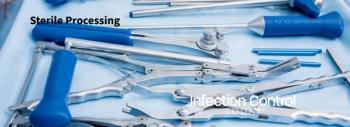
Instrument Reprocessing and Infection Control During Pandemics
By William C. Henry Sr., CRCST
The times in which we find ourselves are fraught with peril. Disaster lurks around every corner as media outlets constantly stream images of human suffering that always seems far removed from our front door. However, disaster may very well come to your front door one day, despite feeling safe and distanced from immediate harm. Time passes as we move on to the next situation, never having properly processed the previous event. We begin to create a cognitive dissonance that must be ceased to properly prepare. It is only through preparation and cooperation that we will be able to assist those in their moment of need effectively and efficiently.
The term "pandemic" comes from the Greek “pan demos,” meaning "all people." A pandemic is an epidemic that has spread across a large area. Infection control during pandemics of the past were totally lacking as there was little knowledge of infectious organisms. The lack of infection control continued during the U.S. Civil War (1861-1865) that saw a lack of sterile conditions within the operating room. With very little sterile instruments available, many soldiers died from infections caused by these unsterile instruments.
One of the first recorded pandemics was leprosy, also known as Hansen’s disease. This disfiguring disease has affected humanity for almost 3,000 years. The Centers for Disease Control and Prevention (CDC) notes that leprosy can only be contracted through close contact with an infected person over the course of months. The disease can be treated with several antibiotics administered concurrently.
The bubonic plague, also called the Black Death, first reared its ugly head in 1331. The infection traveled from Asia across Europe and the Middle East, leaving millions of dead in its wake. The disease was spread through a flea-to-rat cycle that was fueled by unsanitary conditions that existed at the time. Once better hygiene was restored, the pandemic event faded. The children’s nursery rhyme, “Ring Around the Rosy,” has its roots during the bubonic plague; infected people often kept flowers in their pockets to dampen the smell emanating from the round, rosy-colored nodules. Ashes, ashes, we all fall down, due to the high mortality rate.
The modern world faces the Ebola virus as the latest bug, having first shown itself in 1976 in the Democratic Republic of the Congo. The recent outbreaks of Ebola have killed thousands of people, primarily in West Africa. The Ebola virus causes hemorrhagic fever in humans and mammals known as Ebola virus disease (EVD). The medical resources required to combat this pandemic is largely unavailable in African countries. The World Health Organization (WHO) has set forth standards and programs aimed at bringing an end to any outbreak.
On Sept. 20, 2014, the CDC announced the first recognized case of Ebola in the United States. A U.S. citizen traveling to Liberia returned to Dallas and was hospitalized on Sept. 28, 2014. Two nurses were infected with the Ebola virus while caring for the patient. Although both nurses were declared to be free of Ebola eight to 14 days later, the fear level among healthcare workers skyrocketed. All things handled safely, can be safely handled. Planning for known pandemic organisms such as Ebola must begin for the field of sterile processing.
The Ebola virus has been transmitted through use of unsterilized needles, body fluids and direct contact. Understanding the modes of transmission will aid in formatting the sterile processing policy and procedures for handling events of this level.
Let’s examine some of the key parts in reprocessing of instrumentation. Diseases and pathogens are transmitted through five modes of transmission: direct contact, indirect contact, vector, airborne, and droplet. All transmissions are basically direct or indirect contact methods. Vector transmission by fleas, bats, rats, and mosquito are highly common. Droplet transmission by airborne means is a very potent form as well. Blood and body fluids are always to be handled with established processes. Understanding the modes pandemics take helps the direct-care provider, as well as the processor of the surgical instrumentation.
When healthcare facilities have instituted clear policy and procedure guidelines for personnel, the fear of handling biohazards is lessened through training. Infection prevention and control during pandemics rests heavily in the hands of the operating room, materials management and sterile processing. The highly trained operating room personnel are always at the frontline of exposure to pathogens. The daily use of aseptic technique during operative procedures helps their personnel to avoid contamination and exposure. The sterile goods in the materials department are critical during disaster level events. The operating room and all other departments survive by the level of inventory in the storeroom. Platforms have come about during these fiscally sound times that may limit availability during a pandemic event. There are many multi-hospital systems that maintain separate warehouses in anticipation of large-scale disasters.
The sterile processing department sits at the hub of the hospital reprocessing wheel. As the emergency rooms fill up, there will be a massive need for reprocessed sterile goods, and the sterile processing department must meet the needs of the sick. The department leadership, having established policy and procedures for each specific pathogen, will maintain the reprocessing cycle. The staff should have access to all documentation on these processes in computerized or printed format. The ability to retain or recall the needed staff is important by updating phone and address listings annually. The sterile processing technicians are trained for these events as they practice universal precautions daily.
The tendency to be reactive during disasters and pandemics will leave us scrambling to provide service in critical situations. The proactive thought process establishes a planning matrix to account for all known possibilities. The plan then notes the desired resources needed to affect the best outcome. There will always be outliers that crop up. Departments will be infinitely more prepared for the appearance of these outliers by being proactive.
The proactive approach can mitigate problems that arise with the use of a disaster plan. Health care facilities have done an excellent job in cooperation with regulatory agencies to develop internal and external disaster plans. We no longer find ourselves as stand-alone hospitals but as major health care systems servicing large segments of a populace. How do you service the public in a time of mass crisis? How do we make sterile goods available? When governmental agencies and operational resources become overburdened, the sterile processing department must be there to fill the needs. The nursing and surgical staff will be critical partners in all processes developed.
The field of sterile processing sits at another point of continual development where it has the opportunity to combat pathogens such as Ebola. The sterile processing discipline often goes unrecognized as the hub of the hospital. Through achieving a proactive pre-disaster plan, we are able to provide proper infection control during pandemics.
Sterile Processing Sample Pandemic Response Checklist
1. Linen
All linen used should be segregated using the appropriate linen disposal methods. One facility may choose to incinerate the soiled linens, while another will re-launder the goods. The guidelines established should be closely followed.
2. Presoaking Instruments
Whatever instrumentation is used during the surgical procedure it is vital that they are pre-rinsed. The pre-rinsing agent should be low-foaming with good adherence to instruments. All used items and rigid containers should then be placed in heavy-duty, sealed maintenance bags. An open enclosed case cart should be staged outside of the operating room. This will aid in preventing cross contamination during transport. Place a disposable cart cover on the cart during the trip to the sterile processing department.
3. Decontamination Room
The decontamination room is the most important portion of the reprocessing cycle. We cannot clean an item if there is bioburden present. I would suggest removing all non-essential stock and carts from the decontamination area prior to arrival of the contaminated cart. Personnel should be attired in the appropriate personal protective equipment (PPE) prior to entering the area. The PPE may consist of fresh scrubs, shoe coverings, double gowning, double gloving, full face shield, goggles, bunny suit and head covering. The individual facility may employ the use of portable air purifying respirators (PAPR) for the decontamination personnel.
Once the technician is fully attired disassembly of the trays can begin in earnest. There must be a clear delineation between clean and dirty as work progresses. The normal cleaning processes take place, as there may be an intentional doubling of exposure times during cleaning. The instruments may be soaked and placed in the ultrasonic cleaner for an extended cycle. Rigid containers and carts should also go through a double cycle. Having a steam, ethylene oxide or hydrogen peroxide sterilizer in the decontamination area will help to facilitate a higher level of immediate disinfection.
4. Terminal Disinfection
Metal instrumentation should be placed on a double length cycle in the washer-disinfector. The door on the clean side must be reclosed at the end of the cycle to restart the unit. The impingement action of the jet arms will render instruments safe for handling in assembly.
5. Electrical Equipment
Sterile processing may receive items from the operating room of an electrical nature. Anesthesia carts and items used in that particular room may be sent for cleaning. Use established department guidelines that will render the devices safe for handling. Thoroughly wipe all surfaces of item with a low foaming broad spectrum detergent. Always check with department leadership before moving forward.
Cleanup
All surfaces in the decontamination area should be wiped down with a low-foaming detergent. Tables, sinks or ultrasonic units should be cleaned per the established policies. Environmental services should be employed at this point to provide a higher level of cleaning to the area.
William C. Henry, Sr., has spent more than 35 years in the fields of sterile processing, surgical services, and materials management, as well as served as a central sterile consultant.
References:
CDC. Hansen’s Disease. National Center for Emerging and Zoonotic Infectious Diseases (NCEZID). Division of High-Consequence Pathogens and Pathology (DHCPP).
CDC. Plague. National Center for Emerging and Zoonotic Infectious Diseases (NCEZID). Division of Vector-Borne Diseases (DVBD).
CDC. National Center for Emerging and Zoonotic Infectious Diseases (NCEZID). Division of High-Consequence Pathogens and Pathology (DHCPP) Viral Special Pathogens Branch (VSPB).
Newsletter
Stay prepared and protected with Infection Control Today's newsletter, delivering essential updates, best practices, and expert insights for infection preventionists.




